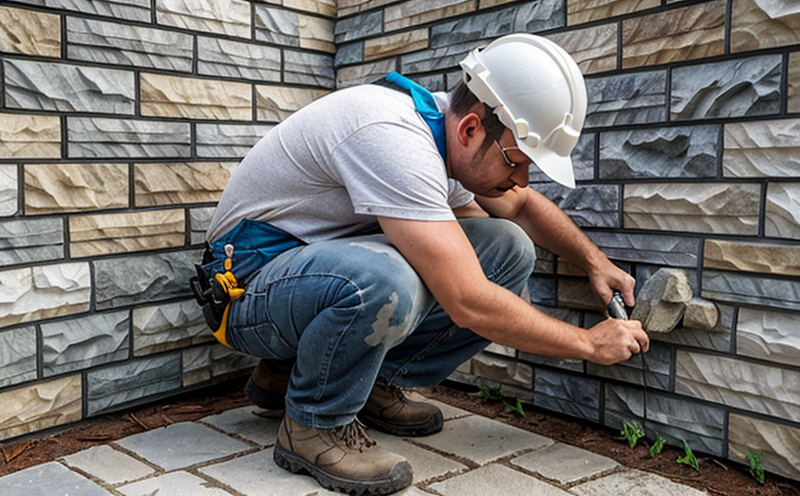Stone cladding inspection
The inspection of stone cladding is a critical process within the construction and building industry. Stone cladding, often used in exterior facades and interior walls, serves both aesthetic and functional purposes. It requires thorough evaluation to ensure durability, safety, and compliance with relevant standards.
Stone cladding can be made from various materials such as granite, marble, limestone, and quartzite. Each material has unique properties that influence its performance in different environments. The inspection process ensures that the stone meets specified quality criteria, which vary depending on the intended use of the building.
The scope of stone cladding inspection includes several key aspects: visual assessment for surface imperfections, color consistency, and grout line uniformity; dimensional accuracy checks to ensure the stones fit together correctly; strength testing using methods like point load or modulus of rupture (MOR) tests; weather resistance evaluation through exposure tests; and compliance with relevant standards such as ASTM C1364, EN 772-6:2019, and ISO 18152.
For the visual inspection, trained professionals examine each piece of stone for cracks, chips, or discoloration. Dimensional accuracy is checked using calipers to ensure that the stones are within specified tolerances. Strength testing helps determine if the material can withstand anticipated loads and impacts without failing. Weather resistance tests simulate real-world conditions to predict long-term performance.
The methodology behind stone cladding inspection involves several steps:
- Initial site survey to identify specific areas requiring attention.
- Sampling of representative pieces for detailed testing in the laboratory.
- Application of appropriate standards and guidelines during all inspections.
- Data analysis to compile results and draw conclusions about compliance levels.
The goal is to ensure that stone cladding installations meet high-quality standards, enhancing the longevity and safety of buildings. This process not only protects against potential damage but also ensures compliance with local regulations and industry best practices.
Scope and Methodology
The scope of stone cladding inspection is comprehensive, covering various aspects to ensure the quality and integrity of the material used in construction projects. Visual inspection plays a crucial role in identifying surface irregularities and inconsistencies that could affect the overall appearance and durability of the cladding.
| Aspect | Description |
|---|---|
| Visual Inspection | Examining stones for cracks, chips, discoloration, and grout line uniformity. |
| Dimensional Accuracy | Checking stones against specified tolerances using calipers. |
| Strength Testing | Assessing the material's ability to withstand loads and impacts through point load or MOR tests. |
| Weather Resistance Evaluation | Evaluating how well the stone resists environmental factors like moisture, freeze-thaw cycles, and UV radiation. |
The methodology for conducting these inspections involves several key steps:
- Conducting a site survey to identify areas that need particular attention.
- Selecting representative samples from the installation for detailed testing in controlled laboratory conditions.
- Adhering strictly to relevant standards and guidelines throughout all inspection processes.
- Analyzing collected data comprehensively to derive reliable conclusions regarding compliance levels.
The use of advanced technologies such as laser scanning and digital photography enhances the accuracy and efficiency of inspections. These tools provide detailed imagery and precise measurements, which are invaluable in ensuring that every aspect of stone cladding meets required specifications.
Industry Applications
In the construction industry, stone cladding is widely used for both residential and commercial projects. It serves as a decorative element while also providing structural support in many instances. The application of stone cladding varies depending on the project's requirements:
- Residential Projects: Stone cladding can be found on exteriors of homes, including facades and fireplaces.
- Commercial Buildings: It is commonly used in corporate office buildings, hotels, and retail spaces for their lobbies and walls.
- Public Structures: Stone cladding enhances the appearance of schools, hospitals, and government buildings.
The choice of stone material depends on factors such as location, climate, and aesthetic preferences. For instance, granite is popular in regions prone to harsh weather conditions due to its durability, while limestone may be preferred for more temperate climates where aesthetics are prioritized.
Incorporating stone cladding into projects requires careful planning and execution to ensure that the material meets all necessary specifications. Proper installation techniques and ongoing maintenance practices are essential to preserve the appearance and performance of the cladding over time.
Use Cases and Application Examples
Stone cladding inspection plays a vital role in ensuring that stone materials used in various construction projects meet quality standards. Here are some typical use cases:
- Residential Projects: Inspection ensures that the stones for facades, fireplaces, and interior walls comply with design specifications.
- Commercial Buildings: Stone cladding on office buildings, hotels, and retail spaces must pass rigorous testing to ensure durability and appearance.
- Public Structures: Hospitals, schools, and government buildings benefit from inspections that guarantee structural integrity and aesthetic appeal.
| Project Type | Main Use Case | Standards Applied |
|---|---|---|
| Residential Projects | Ensuring stones for facades, fireplaces, and interior walls meet design specifications. | ASTM C1364, EN 772-6:2019, ISO 18152 |
| Commercial Buildings | Maintaining durability and appearance through rigorous testing. | ASTM C1364, EN 772-6:2019, ISO 18152 |
| Public Structures | Guaranteeing structural integrity and aesthetic appeal. | ASTM C1364, EN 772-6:2019, ISO 18152 |
Examples of successful stone cladding projects include:
- Hospital Facade Renovation: A comprehensive inspection ensured that the granite used in the renovation project complied with all necessary standards.
- Corporate Office Lobby: Stone cladding on the lobby walls was inspected to ensure it would withstand high traffic and harsh environmental conditions.
- School Exterior Facade: Inspections were conducted to guarantee that the stone used in the facade would maintain its appearance throughout the building's lifecycle.
In each case, thorough inspection processes helped ensure compliance with relevant standards and provided peace of mind for stakeholders involved in these projects.





